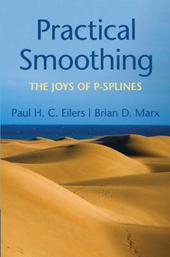
|
Practical Smoothing: The Joys of P-splines
Hardback
Main Details
Description
This is a practical guide to P-splines, a simple, flexible and powerful tool for smoothing. P-splines combine regression on B-splines with simple, discrete, roughness penalties. They were introduced by the authors in 1996 and have been used in many diverse applications. The regression basis makes it straightforward to handle non-normal data, like in generalized linear models. The authors demonstrate optimal smoothing, using mixed model technology and Bayesian estimation, in addition to classical tools like cross-validation and AIC, covering theory and applications with code in R. Going far beyond simple smoothing, they also show how to use P-splines for regression on signals, varying-coefficient models, quantile and expectile smoothing, and composite links for grouped data. Penalties are the crucial elements of P-splines; with proper modifications they can handle periodic and circular data as well as shape constraints. Combining penalties with tensor products of B-splines extends these attractive properties to multiple dimensions. An appendix offers a systematic comparison to other smoothers.
Author Biography
Paul H. C. Eilers is Professor Emeritus of Genetical Statistics at the Erasmus University Medical Center Rotterdam. He received his Ph.D. in biostatistics. His research interests include high-throughput genomic data analysis, chemometrics, smoothing, longitudinal data analysis, survival analysis, and statistical computing. He has published extensively on these subjects. Brian D. Marx is Professor in the Department of Experimental Statistics at Louisiana State University. He received his Ph.D. in statistics. His main research interests include smoothing, ill-conditioned regression problems, and high-dimensional chemometric applications, and he has numerous publications on these topics. He is currently serving as coordinating editor for the journal Statistical Modelling. He is coauthor of two books and is a Fellow of the American Statistical Association.
Reviews'The title says it all. This is a practical book which shows how P-splines are used in an astonishingly wide range of settings. If you use P-splines already the book is indispensable; if you don't, then reading it will convince you it's time to start. Every example comes with an R-program available on the book's web-site, an important feature for the experienced user and novice alike.' Iain Currie, Heriot-Watt University 'This book is an enlightening and at the same time extremely enjoyable read. It will serve the applied statistician who is looking for practical solutions but also the connoisseur in search of elegant concepts. The accompanying website offers reproducible code and invites to promptly enter the fascinating universe of P-splines.' Jutta Gampe, Max Planck Institute for Demographic Research 'Everything you always wanted to know about P-splines, from the inventors themselves. Paul H.C. Eilers and Brian D. Marx make a compelling case for their claim that P-splines are the best practical smoother out there, providing intuition, methodology, applications, and R code that clearly demonstrate the power, flexibility, and wide applicability of this approach to smoothing.' Jeffrey Simonoff, New York University 'This is the book that everyone working on smoothing models should keep handy. At last we have a manuscript that shows the real power of P-splines, their versatility, and the different perspectives you can take to use them. Chapters 1 to 3 will certainly appeal to those who want to start working in this field, and to researchers that need to deepen their knowledge of this technique. Scientists and practitioners from other areas will find chapters 4 to 8 very useful for the wide range of examples and applications. The companion package and the fact that all results (even figures) are reproducible is a real bonus. Thank you Paul and Brian for being truthful to your motto: 'show, don't tell'.' Maria Durban, University Carlos III de Madrid
|